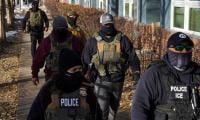PTI’s new structure: A surprise omission, a good addition
ISLAMABAD: There is a big omission and a positive inclusion in the new organizational structure of the Pakistan Tehreek-i-Insaf (PTI) that Prime Minister Imran Khan, in his capacity as the party chairman, has introduced after the debacle it faced in the first phase of local elections in Khyber Pakhtunkhwa (KP).
Foreign Minister Shah Mahmood Qureshi, who has been the PTI’s vice chairman since long, has been left out in the new structure, which has been put in place to enable the party to show a better performance in the forthcoming local government polls in Punjab and the remaining districts of KP.
Qureshi is silent on the new arrangement. Neither he nor any other PTI leader has spoken a word about his exclusion. There was a time when there seemed to be a serious tussle between Qureshi and Jahangir Tareen within the party and Imran Khan used to perform a balancing act and engage in firefighting to keep both within his fold. With Tareen out of the PTI, to the great satisfaction of the foreign minister, Qureshi has not been kept on his old prestigious position of vice chairman.
From among the party figures that have been chosen for the key posts in the new structure, Defence Minister Pervez Khattak’s inclusion is of great consequence given his track record of successful political wheeling-dealing in KP, his personal standing and acumen. He belongs to the breed of traditional politicians that believes in keeping cordial relations with political rivals and taking them along. Khattak also has his own constituency where he, as well as certain members of his family, have been winning consecutive elections. During his tenure as the KP chief minister, even his adversaries did not have too many complaints against him.
The PTI had grabbed a phenomenal victory in KP in 2018 by winning the elections for a second consecutive time after Khattak’s five-year rule as the chief minister. The incumbency factor, which generally goes against the outgoing government in KP, had not affected the PTI’s electoral performance. Rather it had added to its gains. One example of Khattak’s political shrewdness was when all the federal and provincial legislators of the PTI had handed over their resignations to the speakers in 2014 on Imran Khan’s orders, he had not agreed to the idea and had stuck to the position that the party would benefit more if its KP lawmakers remained in place.
Except Khattak, all other PTI leaders who have been given senior party offices in the fresh structure are wholly dependent on the charisma and appeal of Imran Khan and would find it difficult to bring any influential persons to the PTI fold or keep the present lot in.
Like some other principal political parties, the PTI also revolves around one man – Imran Khan. Even the limited relevance, impact and influence of the PTI’s new office-bearers will hardly matter in running and managing the party in the provinces at the micro and grassroot levels for organizational purposes. How far the new secretary general Asad Umar will be successful in this connection is anybody’s guess. He is a decent, outspoken person, who can give good presentations and briefings on different issues but lacks the quality of interacting with ordinary people to impress them.
Federal Minister Khusro Bakhtiar, who has been made the president of southern Punjab, also has his own constituency. While being part of the southern province front of the Saraiki belt, he had joined the PTI just before the 2018 parliamentary polls. His brother, who is the finance minister in Punjab, had returned from a Punjab assembly seat from Rahim Yar Khan. How far Khusro Bakhtiar will be able to bring in winnables to the party in the next general elections is yet to be seen.
Federal Minister Shafqat Mahmood is a refined man but is not a typical leader of the masses and has no background to lead this important branch of the PTI. He is in-charge of the politically most significant region, Punjab, specifically its central part where the Pakistan Muslim League-Nawaz (PMLN) is electorally most popular.
It is well known that the PTI has been a house divided in Sindh especially Karachi where federal minister Ali Zaidi has been playing a role. It will be a huge challenge for him to make any worthwhile contribution to the party or help bury its internal strife in the Sindh metropolis where the PTI showed an impressive performance in the 2018 polls.
Sardar Yar Muhammad Rind, who has always been skeptical of the PTI’s policies in Balochistan, has been ignored in the new organizational set-up. National Assembly Deputy Speaker Qasim Suri has been preferred as the Balochistan president. In view of the peculiarities of Balochistan politics, he has a limited role to play.
Generally, anyone elected as the speaker or deputy speaker resigns his party position for moral reasons to present himself as a neutral person. The opposite has happened in this case.
Aamir Mahmood Kayani, who has been made additional secretary general, is an old hand in the party. Sometime back, he was removed as the federal health minister after a controversy cropped up over the massive hike in drug prices.
-
 First Poll Since King Charles' Action Against Andrew Reveals Royal Family's Public Standing
First Poll Since King Charles' Action Against Andrew Reveals Royal Family's Public Standing -
 Blake Lively Strengthens Legal Team Ahead Of Justin Baldoni Trial
Blake Lively Strengthens Legal Team Ahead Of Justin Baldoni Trial -
 'Back To School!': Palace Shares Details Of Princess Anne's Latest Engagements
'Back To School!': Palace Shares Details Of Princess Anne's Latest Engagements -
 Paul Mescal Clarifies Acting Break Comment As He Teases Paul McCartney Role
Paul Mescal Clarifies Acting Break Comment As He Teases Paul McCartney Role -
 Kate Middleton's Unexpected Style Of Arrival At Solo Outing Goes Viral
Kate Middleton's Unexpected Style Of Arrival At Solo Outing Goes Viral -
 Why ‘X’ Is Down? Thousands Report Twitter Outage: Here’s What You Can Do
Why ‘X’ Is Down? Thousands Report Twitter Outage: Here’s What You Can Do -
 Florida Man Held After Alleged Nail-scattering On Busy Intersections
Florida Man Held After Alleged Nail-scattering On Busy Intersections -
 Valeria Nicov: Sean Penn's Athletic Girlfriend Raises Eyebrows With Latest Photos
Valeria Nicov: Sean Penn's Athletic Girlfriend Raises Eyebrows With Latest Photos -
 Sharon Stone Lashes Out At Fellow Award Show Attendees After Stealing Accusations
Sharon Stone Lashes Out At Fellow Award Show Attendees After Stealing Accusations -
 Gwyneth Paltrow Reveals Real Reason She Said Yes To 'Marty Supreme'
Gwyneth Paltrow Reveals Real Reason She Said Yes To 'Marty Supreme' -
 King Charles Says He And Queen Camilla Stand With People Of Ukraine
King Charles Says He And Queen Camilla Stand With People Of Ukraine -
 Ben Affleck Argues In Favour Of His Shirtless Scene In 'The Rip'
Ben Affleck Argues In Favour Of His Shirtless Scene In 'The Rip' -
 Mississippi Postal Worker Arrested After Complaints Of Marijuana Odour In Letters
Mississippi Postal Worker Arrested After Complaints Of Marijuana Odour In Letters -
 Canada, China Lock Initial Trade Deal On ‘EV,Canola’ To Strengthen Ties: What To Expect Next?
Canada, China Lock Initial Trade Deal On ‘EV,Canola’ To Strengthen Ties: What To Expect Next? -
 Melissa Leo On Euphoria Of Winning An Oscar Vs It's Impact On Career
Melissa Leo On Euphoria Of Winning An Oscar Vs It's Impact On Career -
 Meghan Markle, Prince Harry Express 'hope' In Latest Major Statement
Meghan Markle, Prince Harry Express 'hope' In Latest Major Statement



